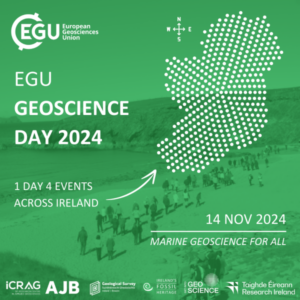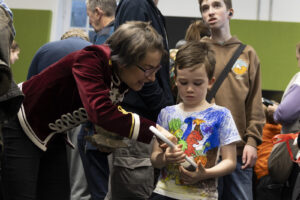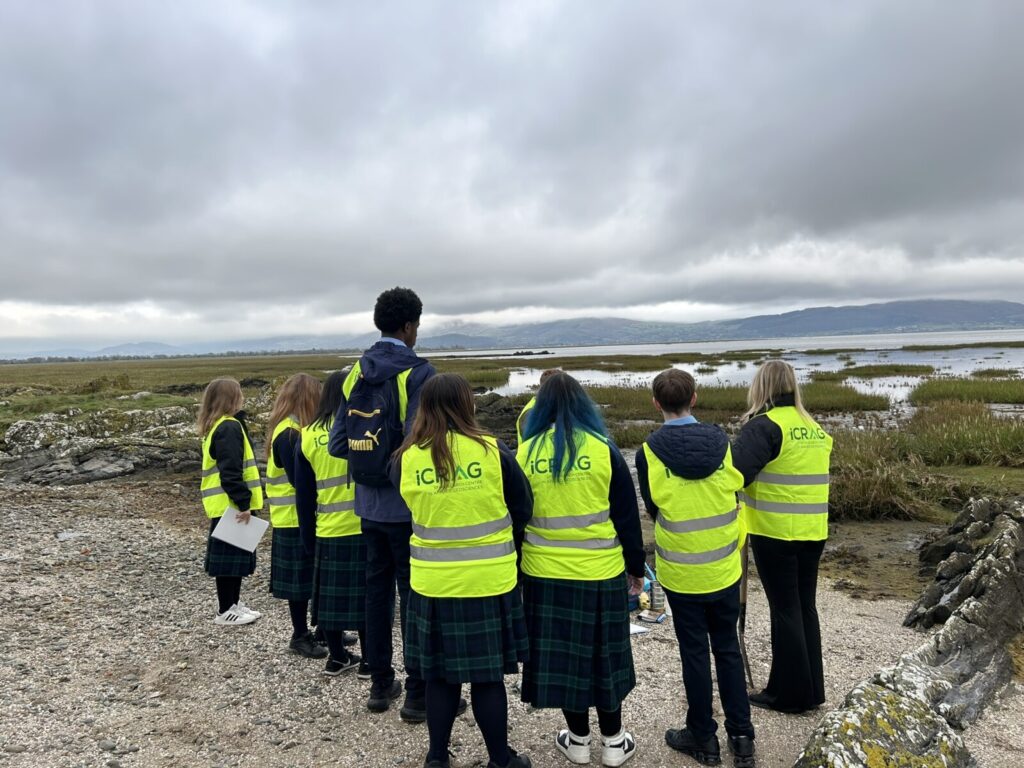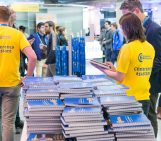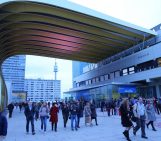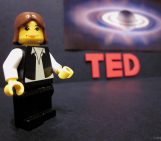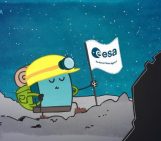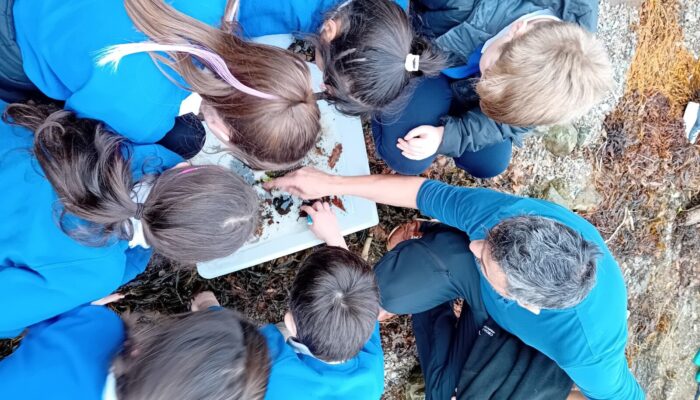
The EGU Geoscience Days connect science with society by funding innovative projects that make Earth, planetary, and space sciences accessible. This year’s spotlight is on our awardee Fergus McAuliffe’s project, Marine Geoscience for All, which used art, storytelling, and dialogue to bring marine geoscience closer to the public. I had the pleasure to interview Fergus again after the events took place in Ireland, so continue reading and find out more about Fergus’s vision and the transformative impact of his award-winning project.
Interested in hosting your own Geoscience Day event in 2025? Check out our current open call and apply here!
Hello, again, Fergus! I am so excited to hear about how the Geoscience Day went! Can you start by telling me how the events play out across the four regions of Ireland? Were there any standout moments that surprised or moved you?
Hey Asmae, thank you for having me again. I am thrilled to share the details of the event with you as the event was a huge success! The four events for Geoscience Day were delivered as planned, with highlights taking place in each of the four locations. You can see the range of activities in the photographs: everything from a marine geoscience art exhibition to storytelling, and from a deep dive into fossils to a field trip to a local beach.
Highlights from each event included the intergenerational meitheal in Mayo, where conversations between older participants and primary school children took center stage. In some cases, there was more than a sixty-year age gap between those in attendance. It was heartening to see the cross-generational dialogue, with old and young coming together to create and populate marine geoscience maps of the local area.
In Dundalk, secondary school students visited Blackrock Cove, where they interacted with geoscientists and a social scientist. They learned firsthand about Dundalk’s glacial past and how soil and mud can reveal insights into past and future environments. They also learned how to test water quality—measuring salinity, oxygen, and pH—and explored Dundalk Bay’s links with human activity.
In Cork, the Fossil Expo celebrated our planet’s ancient past with interactive fossil-themed activities, hands-on games, puzzles, and real marine fossils from Ireland and around the world. Finally, the Foram art event in Dublin unveiled a new video artwork by visual and socially engaged artist AlanJames Burns. The piece drew on Burns’s artistic residency aboard the Celtic Explorer research cruise CE23011. This expedition, led by chief scientist and collaborator Dr. Audrey Morley from the University of Galway and iCRAG, ventured to one of the most remote regions on Earth in July 2023. Amidst the icy expanses of the Arctic Ocean and the Greenland coast, the research team studied Forams, while Burns captured mesmerizing imagery featured in the artwork.
What kind of feedback did you receive from participants, both during and after the events?
The feedback we received indicated that participants thoroughly enjoyed the events, each for different reasons. For example, at the Foram art exhibition, attendees reflected on how the event amplified marginalized perspectives and voices in climate conversations—voices too often excluded. Foram builds on artist AlanJames Burns’s own lived experience and disability-focused arts practice, exploring how climate change disproportionately impacts marginalized and disabled communities. With a focus on accessibility, the video artwork included subtitles, and an Irish Sign Language interpreter facilitated the panel discussion.
At the Get into Geoscience beach school field trip, preliminary evaluation results revealed an increased ability among students to identify geoscience in their school subjects and a greater understanding of geoscience and Blue Carbon.
Were there any logistical challenges in coordinating simultaneous events, and how did your team overcome them?
Event production always has its logistical challenges, although for Geoscience Day here in Ireland, I’m pleased to say that there were very few challenges that stood in our way. As two of our events were outdoors, a big risk and logistical challenge is our lovely Irish weather which is both eminently changeable and unpredictable. Thankfully, the weather gods beamed down on us on the day in question, meaning that both of our events taking place on the beach went ahead as per the original plan. For the Fossil Expo in Cork, demand was expected to be very high, which presented a logistical challenge in managing the high numbers. On the evening itself, our army of volunteers ensured that the families and participants in attendance had a smooth journey through the fossil expo – an achievement in itself given the numbers in attendance!
How did the diverse audiences, from school children to retired individuals, interact with the material and each other?
The beauty of having such diverse events was that audiences could engage with the material in varied ways. At the intergenerational meitheal, older participants shared their reflections with primary school children on what it means to live by Ireland’s only fjord and how the landscape and local activities have changed over their lifetimes. Working together in small groups, they then co-created maps imagining future possibilities for the fjord. Earlier that day, a beach walk introduced participants to how invertebrates can reveal water quality in a fjord, inspiring the children’s imaginative contributions.
What role did the venues, such as the Maritime Museum in Dun Laoghaire, play in enhancing the experience for attendees?
We were fortunate to have excellent event partners in each of the four venues. For Foram, the National Maritime Museum in Dun Laoghaire collaborated closely with us to provide an exceptional experience. The video artwork was installed for ten days, and gave visitors and school groups time to engage with it before Geoscience Day. On the day itself, we repurposed some museum display cabinets to showcase AlanJames Burns’s prints of Forams, adding an artistic flair to the venue.
How did the cultural elements, like the art event in Dublin, enhance participants’ connection to marine geoscience?
The visual art exhibit in Dublin allowed people to consider their relationship with the sea. It reminded people that we all inhabit a vast, interconnected ecosystem, where every being – no matter how big or small – plays a vital role in fostering a harmonious world. Among these, Planktonic Foraminifera, or Forams, are tiny microscopic organisms with an outsized importance. These tiny beings hold essential clues about the Earth’s ancient climate patterns, helping us to better understand the effects of our rapidly changing climate. ‘Foram’ explores how all things, even what can appear as the most isolated and marginalised elements of our world, play a crucial role in protecting our planet. Through attending and experiencing the artwork, ‘Foram’ was a celebration of diverse perspectives, voices and lived experiences and encouraged people to consider how the power of inclusive collaboration can reshape the world towards a more just and sustainable future.
Looking back, were there any unexpected lessons learned from organizing and executing Geoscience Day?
I’m note sure if there was anything unexpected, as the events ran to plan, but something that was reinforced for me was the power of teamwork when it comes to delivering an event such as this. For instance the University College Cork Fossil Day needed an army of committed volunteers (including undergraduates, research staff and academics) to staff an event that saw hundreds of members of the public passing through. The team delivered user-friendly experiments and games, including the very successful Fossil Crime Scene, Walk Like a Dinosaur, the Wheel of Misfortune, Fossil Footprints, Fossil Mix and Match, Fossil Sandpit, Under the Microscope, and a Make Your Own Fossil activity, and not to mention the jewel in the crown in the form of a fossilised ichthyosaur to link the event to Mary Anning’s groundbreaking fossil and marine geoscience work.
How do you plan to use the insights gained from Geoscience Day to shape future public engagement projects?
The biggest insight gained was that it is actually possible to run four events in four different locations at the same time, as long as you have a great coordination team working with you. Each of the consortium partners delivered an event that was tailored to the local audience and reflective of the local area, and without such an experienced and committed team it would not have been possible to deliver such a wide ranging event. Going forward collaboration will be key in shaping future public engagement projects, leaning on the varying expertise that our diverse grouping can bring.
To conclude, I want to pay a sincere thank you to the coordination for all their efforts: AlanJames Burns studios, the National Maritime Museum of Ireland, Ireland’s Fossil Heritage, the School of BEES in University College Cork, Geological Survey Ireland, Joyce Country and Western Lakes Geopark, Get into Geoscience and iCRAG. Geoscience Day here in Ireland would not have been possible without the sustained efforts of the individuals within these organisations who were a pleasure to work with throughout.

